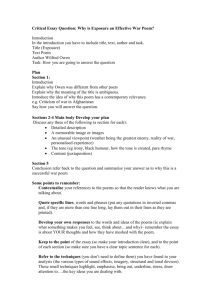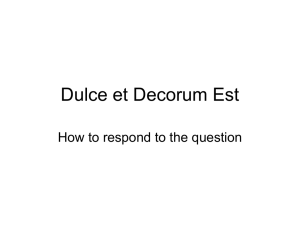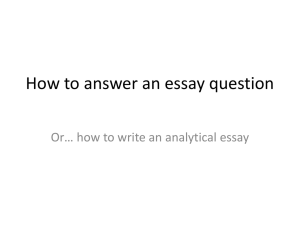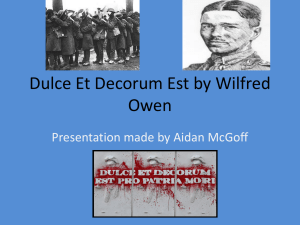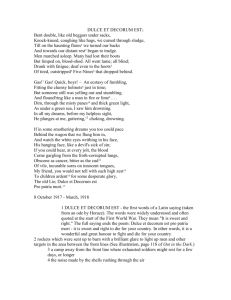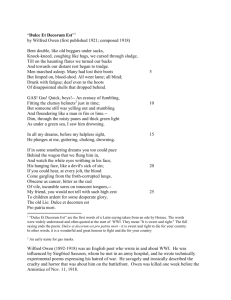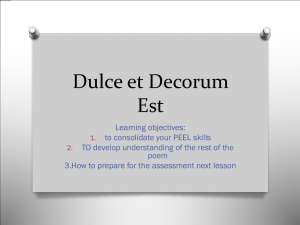Dulce Exemplar Critical Essay plus evaluative tasks
advertisement
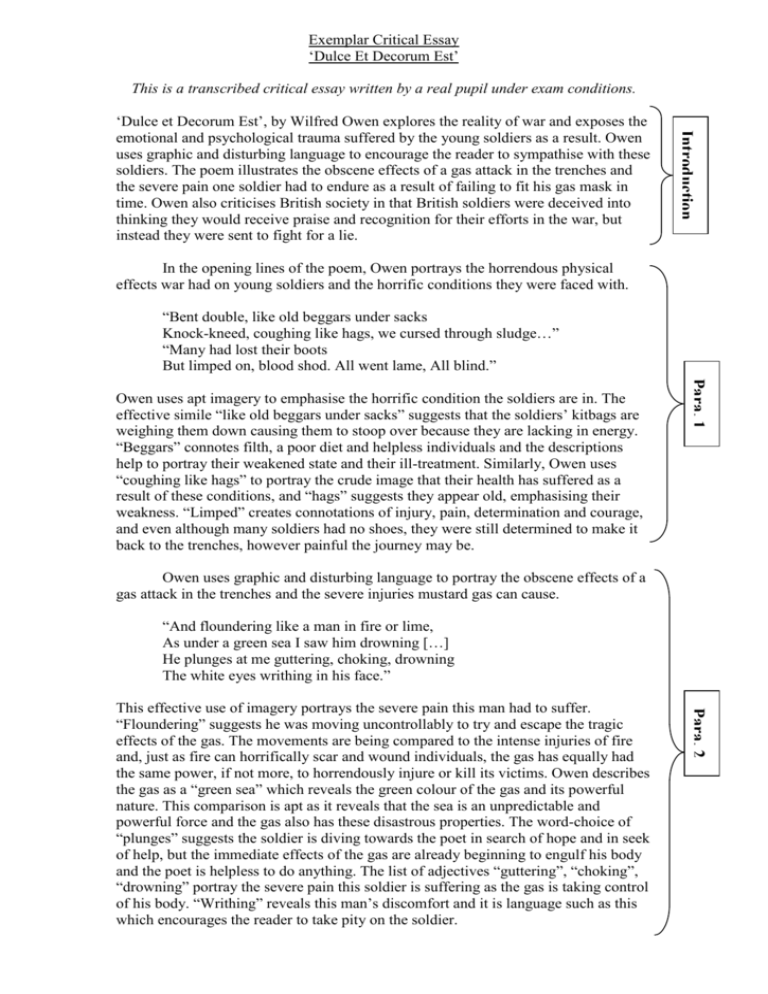
Exemplar Critical Essay ‘Dulce Et Decorum Est’ This is a transcribed critical essay written by a real pupil under exam conditions. Introduction ‘Dulce et Decorum Est’, by Wilfred Owen explores the reality of war and exposes the emotional and psychological trauma suffered by the young soldiers as a result. Owen uses graphic and disturbing language to encourage the reader to sympathise with these soldiers. The poem illustrates the obscene effects of a gas attack in the trenches and the severe pain one soldier had to endure as a result of failing to fit his gas mask in time. Owen also criticises British society in that British soldiers were deceived into thinking they would receive praise and recognition for their efforts in the war, but instead they were sent to fight for a lie. In the opening lines of the poem, Owen portrays the horrendous physical effects war had on young soldiers and the horrific conditions they were faced with. “Bent double, like old beggars under sacks Knock-kneed, coughing like hags, we cursed through sludge…” “Many had lost their boots But limped on, blood shod. All went lame, All blind.” Para. 1 Owen uses apt imagery to emphasise the horrific condition the soldiers are in. The effective simile “like old beggars under sacks” suggests that the soldiers’ kitbags are weighing them down causing them to stoop over because they are lacking in energy. “Beggars” connotes filth, a poor diet and helpless individuals and the descriptions help to portray their weakened state and their ill-treatment. Similarly, Owen uses “coughing like hags” to portray the crude image that their health has suffered as a result of these conditions, and “hags” suggests they appear old, emphasising their weakness. “Limped” creates connotations of injury, pain, determination and courage, and even although many soldiers had no shoes, they were still determined to make it back to the trenches, however painful the journey may be. Owen uses graphic and disturbing language to portray the obscene effects of a gas attack in the trenches and the severe injuries mustard gas can cause. “And floundering like a man in fire or lime, As under a green sea I saw him drowning […] He plunges at me guttering, choking, drowning The white eyes writhing in his face.” Para. 2 This effective use of imagery portrays the severe pain this man had to suffer. “Floundering” suggests he was moving uncontrollably to try and escape the tragic effects of the gas. The movements are being compared to the intense injuries of fire and, just as fire can horrifically scar and wound individuals, the gas has equally had the same power, if not more, to horrendously injure or kill its victims. Owen describes the gas as a “green sea” which reveals the green colour of the gas and its powerful nature. This comparison is apt as it reveals that the sea is an unpredictable and powerful force and the gas also has these disastrous properties. The word-choice of “plunges” suggests the soldier is diving towards the poet in search of hope and in seek of help, but the immediate effects of the gas are already beginning to engulf his body and the poet is helpless to do anything. The list of adjectives “guttering”, “choking”, “drowning” portray the severe pain this soldier is suffering as the gas is taking control of his body. “Writhing” reveals this man’s discomfort and it is language such as this which encourages the reader to take pity on the soldier. The emotional and psychological trauma suffered by the witnessing soldiers is emphasised throughout the poem, and Owen reveals that these memories will haunt them for the rest of their lives. Owen reveals that “all” of his dreams contain references to this gas attack which emphasises that he cannot easily forget these brutal memories. The word choice of “smothering” suggests his dreams are so terrible that they are almost suffocating him. The poet addresses the reader directly with the words “If you”, asking the reader to put themselves in his shoes to experience the harsh memories he is plagued with. Furthermore, the poet recalls “every jolt” of pain and movement as the soldier nears his death, which emphasises that these images are so fresh and clear in his mind and that they are never-ending and unforgettable. Para. 3 “In all my dreams before my helpless sight” … In some smothering dreams you too could pace … If you could hear, at every jolt, the blood Come gargling from the froth-corrupted lungs.” Owen portrays that young men, even children, were desperate to become heroes and so were easily encouraged to sign up for the war: “My friend, you would not tell with such high zest, To children ardent for some desperate glory. The Old Lie: Dulce et Decorum Est Pro Patria Mori” Conclusion “Dulce Et Decorum Est” exposes the hardships of war and the emotional trauma suffered by many soldiers as a result. The brutal consequences of war are clearly emphasised throughout the poem and the injuries they can cause are most likely to be life-threatening. With the uses of graphic and vivid word-choice, Owen produces a poem which stirs up great emotion, leaving the reader deliberating whether it is right and honourable to fight for your country, or more realistically to die for it. Para. 4 The word choice of “zest” portrays that the soldiers are told with pleasure and enthusiasm that it is right and honourable to die for your country. Owen strongly objects to this statement and he believes that the only reason many young men chose to go to war was the fact that they thought they would receive praise and glory for their efforts. He believes that if more people had been made aware of the horrendous conditions, they would not have been so enthusiastic and eager to sacrifice their lives to fight for their country. Owen’s strong opinions are further emphasised when he describes this statement as the “Old Lie”, portraying that the officials are exploiting the naivety of these young men and ultimately forcing them to go to war. This is utterly barbaric and wrong, and the reader is encouraged to sympathise with these soldiers as they embark on a journey that is both mundane and life-threatening. Understanding Strengths and Weaknesses. This is an example of a successful essay on the poem “Dulce Et Decorum Est”. Complete the activities below to analyse its strengths and weaknesses. 1) Based on her introduction and conclusion, write the question you think the pupil was answering. e.g. “Choose a poem which ….. Show how the poet ……” 2) A good introduction contains: i. The title ii. The author/poet iii. A reference to the question iv. A brief summary of the ‘plot’ / ‘story’ v. A mention of the poem’s theme/message Underline and label these 5 features in the exemplar essay’s introduction. 3) This pupil has generally followed the ‘PCQE’ pattern for her essay which gives a clear structure and obvious line of thought. Go through the passage. Use 4 colours of highlighter to highlight which parts of the essay are: - Points / Topic Sentences - Context - Quotations - Evaluation (/Analysis) 4) Look at the main indented quotes. Why does the pupil sometimes use ellipsis (…) in her quotes? 5) One of this pupil’s strengths is her varied and mature vocabulary. Find the words she uses in her essay instead of these boring alternatives: a) looks at (intro) b) tricked (intro) c) awful (para. 1) d) appropriate / good (para. 1) e) bend (para. 1) f) has connotations of (para. 1) g) completely affect / surround (para. 2) h) remembers (para. 3) i) troubled by / bothered by (para. 3) j) innocence (para. 4) k) dull / boring (para. 4) 6) The pupil does use one word too much, making her essay repetitive in place. What is that word? (Hint: it means ‘shows’) 7) Write down one thing which you think makes this essay good. Write down one thing which you think the pupil could do to improve. 8) Your teacher may be able to give you a Critical Essay Marking Grid. (You can also download one from the SQA website.) Use this to decide what mark (out of 25) this pupil should receive.
